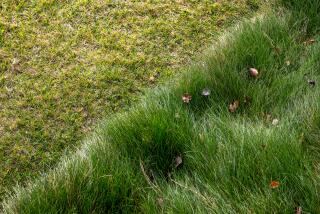Grass-Roots Networking Reaps Green Profits All Year
- Share via
There are two general categories of grass: cool-season and warm-season, and each is dormant in its off season. The ideal lawn is not necessarily made of a single grass type. Mixed lawns can be just as inviting as pedigreed ones and are often more resistant to pests and other problems. And, cool- and warm-season grasses can be blended for a lawn that stays green year-round.
Cool-season grasses
The most common type of cool-season grass found in Southern California is the tall fescue (Festuca arundinacea), which comes in a variety of types and does well in warm weather. This wide-blade, coarse grass has no center vein. It is tough and makes a good playing surface. If watered deeply, it is drought-tolerant. It is also very disease-resistant, isn’t susceptible to thatch and does well in poor soil.
Another common cool-season lawn is Kentucky bluegrass (Poa pratensis). This grass is deep green and has a fairly large blade with a hard-to-detect center vein; the tip of the leaves are slightly cupped. It does best in cooler coastal areas of Orange County, where the temperatures don’t get much above 80 degrees. This grass is not very drought- or shade-tolerant. It is is often found mixed with perennial rye grass (Lolium perenne), which is more disease resistant.
Warm-season grasses
Common warm-season grasses found in the area include hybrid Bermuda grass (Cynodon species), which comes in a variety of types. This hardy, dense, fine-textured grass can be mowed low and is commonly used on athletic fields and for golf courses. It is very heat-tolerant and can withstand drought conditions if watered deeply. This grass goes dormant in winter and does not tolerate shade. It also develops thatch and is invasive, easily spreading into flower beds.
Zoysiagrass (Zoysia species) is another warm-season grass that is heat and drought tolerant. It forms a dense, fine- textured lawn that is relatively free of diseases and insects. It is, however, very slow to establish and can be tough to mow if left too long. Thatch will also build in this lawn type if too much nitrogen is applied.
Another common warm-season grass is St. Augustine (Stenotaphrum secundatum). This is the best choice for shade tolerance. It also does well in salty soil and has few pests. This dark green grass has leaves that get up to 3/8-inch wide on coarse wiry stems. It spreads quickly by surface runners, can invade flower beds and develops thatch.






